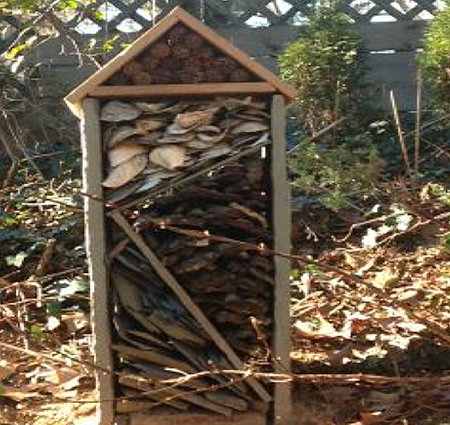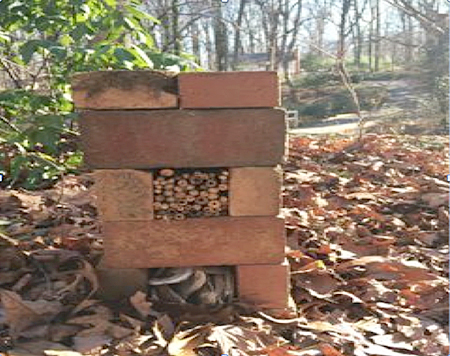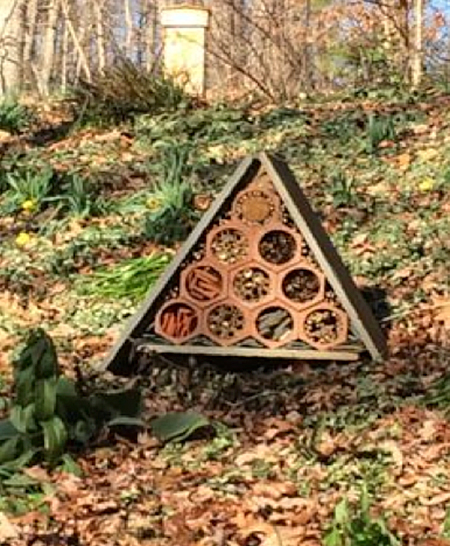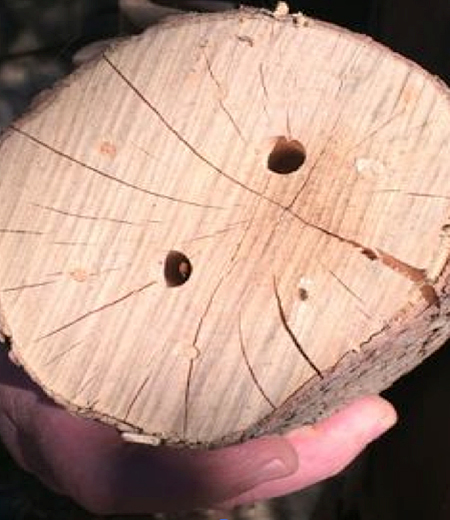
A multitude of insects abound in healthy gardens. Insects are needed to keep ecosystems working – to pollinate plants, to provide food for birds and other animals (as part of the food web), and to increase the overall biodiversity of our gardens. With urban and suburban gardens being so focused on neatness and simplicity, an insect hotel provides a fun way to attract and to shelter insects while also creating a kind of sculptural element that is appealing and beneficial at the same time.
Insect hotels can provide places to breed, places to stay and rest, and provide hibernation habitats. They can be beneficial to domestic honeybees, bumblebees, solitary bees as well as moths, wasps, beetles, lacewings, hover-flies, ladybirds, and earwigs (many of these eat lice and mites that damage plants).
Insect hotels are made primarily with recycled materials such as those that can be gathered around the house and garden. Consider old wood, drilled wood blocks, bundled twigs, bamboo canes, cones, hollow stems, bark, seed pods, straw, hay, cut grasses, paper, old leaves, stones, shells, clay pots, clay pipes, bricks, broken pottery and more. Avoid using metal and for the drilled wood make sure the wood is free of chemicals.
To hold all of the materials a structure is needed as the base, sides and frame for the hotel; in the beginning using bricks as the building block is quite simple. Once a base is set then the sides start going up and materials are placed with the heaviest going on the lowest level.
Pre-roll the paper and leaves, cut hollow reeds, twigs and bamboo prior to construction so that building can move along without distraction.
Create many small holes of different sizes in the untreated wood.
Native bees like the tiny holes as a place to lay their eggs, add pollen and nectar on top and then they add clay for protection. Cavities are important for the insects to crawl on, fly into or to provide a resting place.
Position the hotel where it will not get wet during winter, under the eve of the house, or build the hotel so it has a reliable roof – slate is a good roof material. Dry stone walls also act as successful insect hotels and often have the added benefit of providing habitat for chipmunks, frogs, toads, and salamanders. These are not built to be highly specific for certain insects but rather as a way to imaginatively increase the heterogeneity of your outdoor space.
Insect hotels are quiet places most of the time so don’t expect them to be like Grand Central Station but do expect some surprises. By providing this kind of habitat we are adding rich natural features that support conservation. We create some garden art at the same time. A large part of the fun is to design the hotel so it is pleasing to the eye and then set it in place where it can be enjoyed and observed over time as it is discovered by insects.
Insect Hotel Examples
These insect hotels were made by Dr. Michael L. Smith, Ichthyologist, Beekeeper, Gardener.

This is a simple insect hotel built with bricks – great for a first time effort. The spaces are filled with bamboo, twigs, and oyster shells.

This more complex insect hotel provides a lovely sculptural element set on a hillside garden. The honeycomb design was created with brick pipe and slate is used as the base and sides.

Here the design blends wood and slate set on a stone base and incorporates oyster shells, bark, twigs, and stones.

This log has been part of an insect hotel. Look carefully to notice the very small holes that have been filled in with mud by native bees; these non stinging bees are good pollinators. An egg is laid in the cavity and then the bee adds pollen and nectar which provides food for the bee. Then leaf parts and mud are added to the top.

